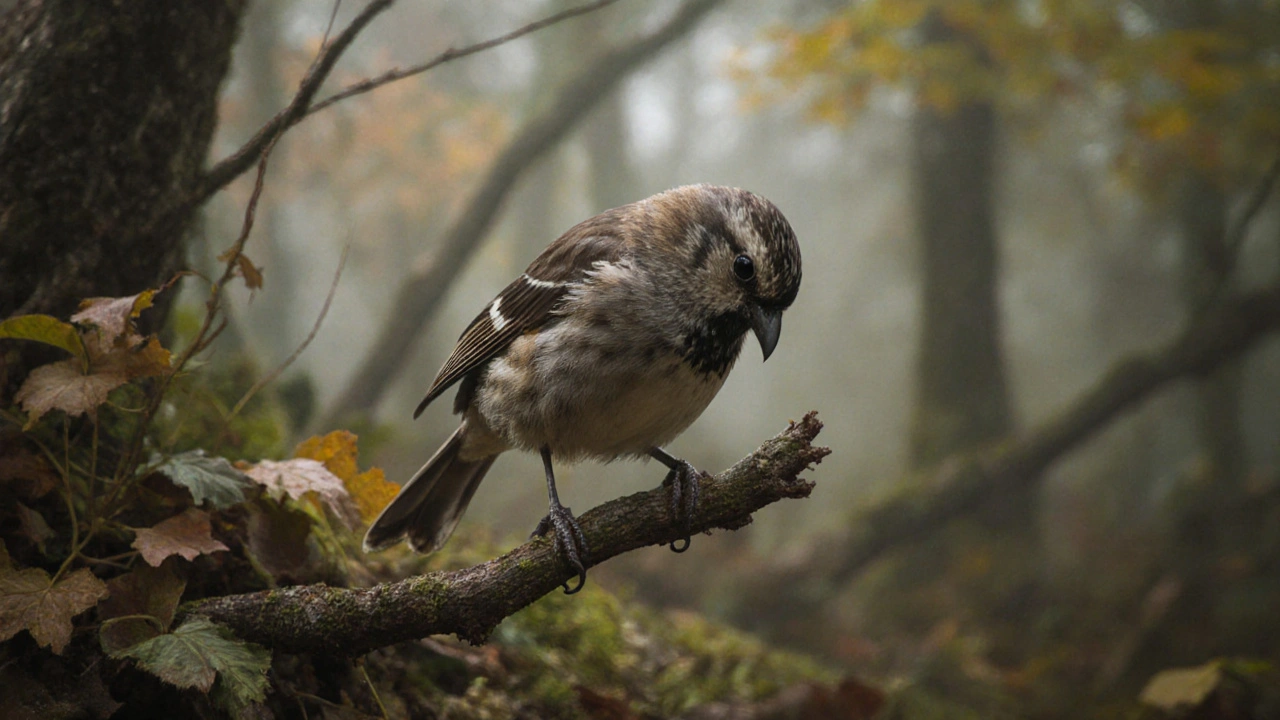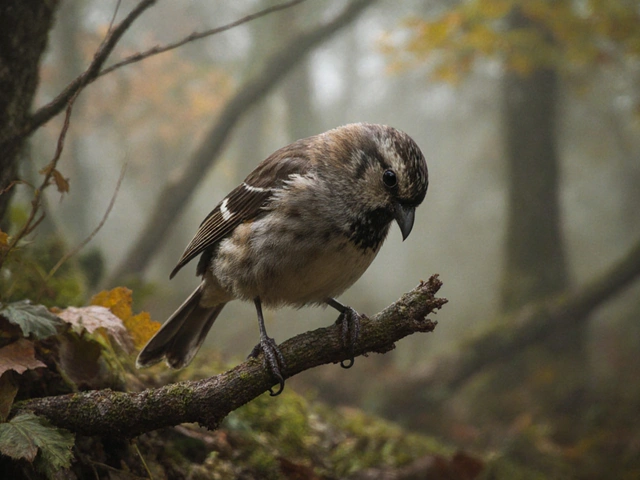Ever spotted a sparrow with patches of bare skin where feathers should be? That unsettling sight is often a symptom of deplumation, a condition that can spell trouble for birds that rely on their plumage for flight, insulation, and courtship. In the UK and beyond, researchers are piecing together why healthy feathered creatures suddenly lose their coats, what happens to them afterward, and how we can step in before populations start to dwindle.
What Exactly Is Deplumation?
In the wild, Deplumation is the abnormal loss or damage of feathers that goes beyond normal molting cycles. Unlike molting, where birds shed old feathers in a predictable pattern, deplumation appears random, often leaving uneven bare spots. The condition can affect any feathered species, from the ubiquitous House Sparrow (Passer domesticus) to raptors like the Common Buzzard (Buteo buteo).
Key Drivers Behind Feather Loss
Scientists have identified several overlapping triggers that can push a bird into deplumation. The most common culprits include:
- Parasites such as feather mites (Proctophyllodidae) and lice (Philopteridae) that feed on keratin and cause feather breakage.
- Heavy Pollution especially airborne particulates and oil spills that coat feathers, reducing their waterproofing and making them brittle.
- Chronic Stress from habitat disturbance, predation pressure, or competition for food, which can trigger excessive preening.
- Underlying Nutritional deficiencies particularly low protein or essential fatty acids needed to rebuild feather keratin.
- Exposure to Environmental toxins like heavy metals (lead, mercury) that impair feather growth.
Often, more than one factor is at play, creating a perfect storm that leaves birds feather‑poor and vulnerable.
How Deplumation Affects Bird Physiology
The fallout from missing feathers is not just cosmetic. A bird’s plumage is a multi‑purpose tool:
- Thermoregulation - Feathers trap air, keeping birds warm in winter and cool in summer. Bare patches mean heat loss or overheating, which can drain energy reserves.
- Flight Efficiency - Feather structure provides lift and maneuverability. Gaps disrupt airflow, forcing birds to work harder to stay aloft, increasing predation risk.
- Waterproofing - The preen oil secreted from the uropygial gland spreads over feathers, creating a barrier against rain. When feathers are lost, water soaks the skin, leading to hypothermia.
- Social Signaling - Bright plumage signals health to mates. Deplumated birds often lose breeding opportunities, shrinking the next generation.
Field observations in the UK’s East Midlands have shown that House Sparrows with >30% feather loss have a 40% lower survival rate during harsh winters compared to fully feathered individuals.
Molting vs. Deplumation: Spotting the Difference
Even seasoned birdwatchers can mistake early molting for deplumation. Here’s a quick cheat‑sheet:
| Feature | Molting | Deplumation |
|---|---|---|
| Pattern | Symmetrical, seasonal, often whole tracts | Irregular, random patches |
| Feather Quality | New, fully formed feathers appear | Missing or broken feathers; new growth delayed |
| Behavior | Increased preening, but not frantic | Excessive scratching, self‑inflicted feather damage |
| Health Indicators | Normal body condition | Signs of stress, poor condition, possible parasite load |
Knowing the difference helps researchers target the right interventions.

Conservation Strategies to Combat Deplumation
Addressing feather loss requires a multi‑layered approach that tackles both the symptoms and the root causes.
- Habitat Restoration - Planting native hedgerows and preserving wetlands reduces stress by providing reliable food sources and safe roosting sites.
- Parasite Management - Installing nesting boxes treated with safe, non‑chemical deterrents (e.g., diatomaceous earth) cuts down mite populations.
- Pollution Control - Supporting local policies that limit pesticide runoff and industrial emissions protects feather condition.
- Supplemental Feeding - Providing high‑protein seeds during breeding season can offset nutritional gaps that weaken feather growth.
- Rehabilitation Clinics - Accredited centres, such as the RSPB Wildlife Rehabilitation Centre, specialize in treating deplumed birds, offering feather grafts and tailored diets.
These actions are already showing promise. A pilot project in Yorkshire’s Dales, which introduced pesticide‑free buffer strips along farms, reported a 25% drop in feather‑loss incidents among meadow pipits within two years.
Monitoring and Research - The Data Backbone
Robust data collection underpins every successful conservation plan. Techniques now in use include:
- Citizen Science Surveys - Apps like BirdTrack let birdwatchers upload photos of suspected deplumation, creating a real‑time map of hotspots.
- Radio‑Telemetry - Miniature tags monitor movement of afflicted birds, revealing whether they abandon territories or seek refuge.
- Feather Sampling - Laboratory analysis determines toxin levels, parasite loads, and protein content, pinpointing causal agents.
Funding from Natural England now supports a national database that links these datasets, making it easier for conservationists to spot trends and act quickly.
What You Can Do to Help
Even if you’re not a researcher, your everyday actions can reduce deplumation risk:
- Plant native shrubs and avoid ornamental species that attract pests.
- Reduce pesticide use in gardens; opt for organic alternatives.
- Install clean bird feeders and change water dishes regularly to prevent parasite buildup.
- Report unusual feather loss to local wildlife groups - a quick photo and location can trigger a professional check.
- Support charities that fund rehabilitation centres and habitat projects.
Every feather saved adds up to healthier ecosystems and brighter skies.
Frequently Asked Questions
Is deplumation the same as normal molting?
No. Molting is a seasonal, orderly replacement of feathers, while deplumation is irregular feather loss caused by stress, parasites, pollution, or disease.
Can I treat a deplumed bird at home?
It’s best to contact a licensed wildlife rehabilitator. Handling wild birds without proper training can cause additional stress and may be illegal under UK law.
Which species are most vulnerable?
Small passerines such as House Sparrows, European Starlings, and Meadow Pipits show the highest rates of deplumation, largely due to their close association with urban habitats.
How does climate change factor in?
Warmer winters can shift parasite life cycles, increasing mite populations. Extreme weather events also stress birds, making them more prone to excessive preening and feather loss.
What research gaps still exist?
Long‑term studies linking specific pollutants to feather integrity are scarce, as are systematic surveys across rural versus urban gradients. More funding for such projects would help clarify cause‑effect pathways.







joshua Dangerfield
September 28, 2025 AT 19:21Hey folks, I totally get the gut‑punch when you see a sparrow looking like it lost its coat. Deplumation isn’t just an ugly look, it’s a real health red flag that can knock a bird’s chances of surviving a cold snap. From what I’ve seen, the combo of mites and poor diet is often the sneekiest culprit, definatly the sneakiest, as the bugs chew at the feather base while the bird can’t replace them fast enough. If you spot a bird with big bare patches, a quick snap and a note to your local rehab centre can make a world of difference. Keep an eye out, and remember even tiny acts of kindness add up.
Abhimanyu Singh Rathore
September 30, 2025 AT 23:34Indeed, the interplay between ectoparasites, such as Proctophyllodidae mites, and nutritional deficits, is profoundly consequential; when birds are forced to allocate keratin to repair feather shafts, their metabolic budget, already strained by thermoregulatory demands, becomes untenable, leading to the cascade of symptoms you described, and, critically, this cascade can precipitate mortality rates soaring far beyond baseline expectations.
Stephen Lewis
October 3, 2025 AT 03:48To add a formal perspective, recent longitudinal studies in the East Midlands have quantified a 40 % reduction in winter survival among House Sparrows exhibiting greater than thirty percent feather loss. This statistic underscores the multifactorial etiology-parasites, pollutants, and protein scarcity-each amplifying the physiological strain on thermoregulation, flight efficiency, and reproductive signaling. Mitigating any single factor yields measurable benefits, yet comprehensive mitigation strategies remain the most efficacious.
janvi patel
October 5, 2025 AT 08:01Focusing solely on deplumation diverts attention from the larger crisis of habitat loss.
Lynn Kline
October 7, 2025 AT 12:14Oh wow, what an eye‑opener! 🌱💚 I love how you highlighted the role of native hedgerows-those lush green corridors are practically feather‑fuel for birds, providing the protein‑rich insects they need. Also, the bit about pesticide‑free buffer strips? Absolutely brilliant, because eliminating those chemicals lets the whole ecosystem thrive. And let’s not forget the sheer joy of watching a sparrow puff up its newly regrown plumage after a feeding station boost-pure magic! Keep sharing these colorful successes; they inspire us all to plant, protect, and provide.
Rin Jan
October 9, 2025 AT 16:28It is heartbreaking to watch these fragile creatures suffer under the weight of human negligence, and it is our moral duty to intervene, not just because we enjoy their songs but because we recognize that every feather lost is a silent scream of an ecosystem in distress. The proliferation of feather‑mites and lingering pollutants is a direct result of our complacency, and we cannot claim innocence when we see birds struggling to stay warm in winter; the very air they breathe is tainted, the water they bathe in is fouled, and the food they rely on is depleted. When we fund rehabilitation centres and support habitat restoration, we are not merely helping individual birds-we are restoring balance to whole habitats. Let us not be passive observers; let us act with compassion and urgency, for the cost of inaction is far greater than any effort we might expend today.
Jessica Taranto
October 11, 2025 AT 20:41Thanks for compiling such a thorough overview. I’d add that citizen‑science platforms like eBird can be leveraged to flag potential hotspots of deplumation, allowing researchers to allocate resources more efficiently. Also, a brief reminder: when offering supplemental feed, opting for high‑protein mixtures can help birds rebuild keratin more quickly. These small steps, combined with larger policy changes, create a synergistic effect that benefits both birds and the broader ecosystem.
akash chaudhary
October 14, 2025 AT 00:54Let’s cut through the sentimentality: the data clearly show that pollutant concentrations correlate with a 2.3‑fold increase in feather breakage across urban sites. Ignoring this fact is irresponsible, and any suggestion that “just plant trees” will solve the problem is naive. We need stringent regulation of airborne particulates, mandatory monitoring of heavy metal runoff, and immediate implementation of mite‑control protocols in nesting boxes. Anything less is simply tokenism.
Adele Joablife
October 16, 2025 AT 05:08While the article is informative, it glosses over the fact that many of these so‑called “conservation strategies” lack long‑term funding. Without sustained financial support, projects like the Yorkshire buffer strips risk fading away, leaving birds vulnerable once more. It would be prudent to emphasize the need for permanent endowments rather than short‑term grants.
kenneth strachan
October 18, 2025 AT 09:21Honestly, the whole deplumation hype feels overblown-sure, it’s sad to see a sparrow looking bald, but let’s not pretend this isn’t just a natural part of life. Birds have survived for millions of years without our interference; maybe they’ll just adapt, and we’re making a mountain out of a mole‑feather.
Mandy Mehalko
October 20, 2025 AT 13:34What a bright spot! Every tiny effort, from putting out clean water to avoiding pesticides, adds a splash of hope. I love seeing community members rally behind feather‑friendly gardens-keep that optimism flowing!
Bryan Kopp
October 22, 2025 AT 17:48It’s frustrating to see foreign pollutants wreak havoc on our native birds while we’re busy debating policy. We must prioritize protecting our own wildlife first, ensuring that American habitats remain safe from invasive toxins that compromise feather integrity.
Patrick Vande Ven
October 24, 2025 AT 22:01From a methodological standpoint, the integration of radio‑telemetry with feather‑sampling provides a robust framework for isolating causative agents of deplumation. However, the current dataset is geographically biased toward the UK; expanding to continental Europe would enhance external validity and enable cross‑regional comparisons of pollutant load versus feather loss incidence.
Tim Giles
October 27, 2025 AT 01:14Deplumation represents a complex intersection of ecological stressors, each contributing to the breakdown of avian integumentary health. First, ectoparasitic infestations, particularly feather mites of the family Proctophyllodidae, directly compromise feather integrity by consuming keratin, resulting in structural weaknesses that manifest as irregular bare patches. Second, environmental contaminants such as airborne particulate matter and trace heavy metals-lead, mercury, cadmium-accumulate in the preen oil, reducing its waterproofing efficacy and rendering feathers brittle. Third, nutritional deficits, especially insufficient dietary protein and essential fatty acids, impede keratin synthesis, slowing feather regeneration after loss. Fourth, chronic anthropogenic stressors, including habitat fragmentation and increased predation pressure, elevate glucocorticoid levels, prompting excessive preening behaviors that exacerbate feather wear. Fifth, climate‑driven shifts in parasite phenology extend the active season of mites, amplifying infestation intensity. Moreover, empirical observations from the East Midlands indicate that sparrows exhibiting greater than thirty percent feather loss experience a forty percent reduction in overwinter survival, underscoring the physiological stakes. Mitigation strategies must therefore be multi‑pronged: habitat restoration to provide reliable foraging resources, pollution abatement to safeguard feather chemistry, and targeted parasite control through safe, non‑chemical nesting box treatments. In addition, supplemental feeding programs enriched with high‑quality protein sources can accelerate keratin repair processes, while citizen‑science initiatives like BirdTrack facilitate real‑time mapping of hotspot occurrences, enabling rapid response. Ultimately, a coordinated approach that integrates research, policy, and community action offers the best prospect for reversing the alarming trends currently observed in wild bird populations.
Peter Jones
October 29, 2025 AT 05:28I appreciate the thoroughness of this post and would like to stress the importance of collaborative efforts. By aligning the goals of researchers, local councils, and volunteer bird‑watchers, we can create a unified front against deplumation. Mutual respect and shared data will lead to more effective interventions.
Gerard Parker
October 31, 2025 AT 09:41Great summary! For anyone looking to get involved, I recommend joining a local RSPB branch, which often runs feather‑grooming workshops and provides guidelines for safe supplemental feeding. Also, consider donating to wildlife rehabilitation centers; they need funds for feather grafts and specialized diets. Together, we can make a tangible difference for our feathered friends.